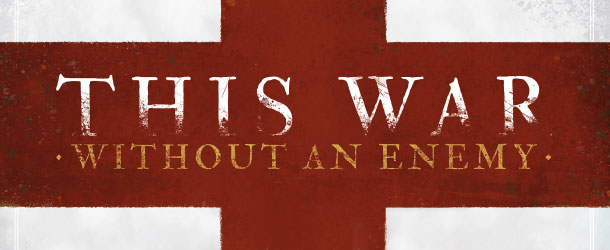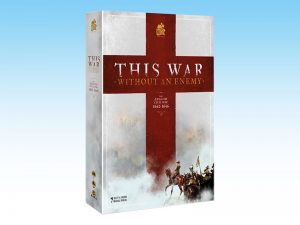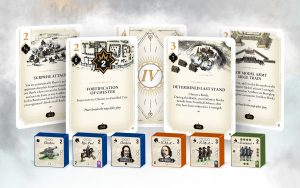The first English Civil War was the most significant of a series of conflicts that raged across England, Scotland, and Ireland during the middle of the 17th century. The three kingdoms were all ruled by King Charles I, whose unpopular religious policies sparked two wars with his Scottish subjects, while his fights with the English parliament over money also escalated into armed conflict. The Royalist forces fighting for the king were opposed by the English Parliamentarian troops and their Scottish allies in a struggle for political, economic, and religious control of England.
The conflicting loyalties and passions of the “Wars of the Three Kingdoms” live again in This War Without an Enemy, a 2-player strategic block wargame designed by Scott Moore, published by Nuts! Publishing, and distributed in North America by Ares Games. In the game, one player represents the Royalists, and the other player controls the Parliamentarians and their Scottish Covenanter allies.
The game engine is that of a card-driven “block” wargame: wooden stand-up counters hide the true nature of units on the board, creating a “fog of war” effect, while the cards in hand drive the players’ actions. These core mechanics are improved by several innovations to simulate both the warfare of the time and the unique nature of this conflict. The usual block game mechanics for field battles have been modified with special rules for artillery, cavalry, and infantry, while a completely new system has been designed for storming and sieges.
Every player has their deck, and the card decks are adjusted from year to year to reflect the historical progression of the war. Players acquire Victory Points through the capture of cities held by the opponent, while the Parliamentarians can move closer to victory by capturing the King. Five different scenarios are included.
The game map depicts England and Wales, the scene of the conflict, split into five Regions and further divided into Areas, as well as parts of Scotland, Ireland, and ‘The Continent’, from which other forces may enter the war. New troops that can be raised in England and Wales are represented by blocks kept in the Recruitment Areas. Blocks that enter the game through major events or through card play remain off map.
The blocks are colored blue for the Royalists, orange for the Parliamentarians, and green for their Covenanter allies. Each block has a Tactical Rating, based on its class – Artillery, Cavalry, or Infantry – and an effectiveness from 1 to 3. Most of the blocks have a designation showing their home Region, which places restrictions on their movement and ability to recruit. The most important generals are represented by their own blocks and are either Leaders or Regional Leaders, with the ability to take regional blocks out of their home Region.
At the beginning of each Year, players draw a hand of six cards, corresponding to the number of turns to be played – the exception is the first year, 1642, with only two turns. Each Turn consists of five Phases played in sequence.
In the Initiative Phase, each player plays a card to determine the player order for the Strategic Phase, in which each player, in turn, spends the action points on the card they played to move blocks and/or recruit. Battles and siege combats take place in the Tactical Phase. Battles are resolved on the Battle Mat. This helps players to keep track of the timing of the battle and the interaction between the blocks. There are different sections for each class of block, as well as for reserves and for off-battlefield cavalry. There are specific rules for each class of block that reflect the use of the different types of soldiers on a mid-17th century battlefield.
In the Supply Phase, blocks exceeding the supply limit of an area are reduced in strength, and in the Victory Phase, if the marker on the Victory Track has reached 3 or more VPs for a player’s side, then that player has won the game (the game ends anyway in the year 1646). In the Winter Turn, there is a further Phase, the Year End Phase: new blocks are added, regional recruitment takes place, regional blocks return home, and the card decks are prepared for the next year.
The 24-page rulebook includes hints on playing the game, presenting Royalist and Parliamentarian strategies and tactical considerations.
With its innovative game mechanics, This War Without an Enemy allows the players to recreate the Wars of the Three Kingdoms. Will history be repeated with victory for Parliament and the execution of Charles I? Or will the divine right of Kings prevail over the Roundhead rebels and usher in a new era of absolute monarchy?
* This preview article was originally published by Game Trade Magazine, issue 265 (March 2022).













Follow Us on